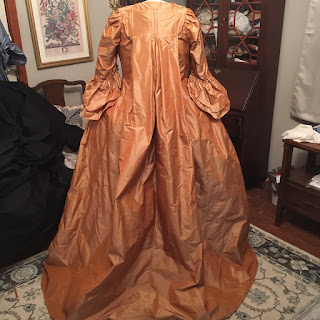So while other girls are swooning over the airy pastels and mountains of faux flowers and oodles of lace from the 1760s and 70s (although I love those too), it's the generally un-trimmed, monolithic ladytents of the 1720s and 30s that have my heart. The women in the paintings of the time look powerful, in-control, even dominant in situations of romance. Their bodies are not the main focus of the fashion (not that there's anything wrong with that!), rather, it's the wealth and luxuriousness that they radiate in their choice of fabric. Possibly even the de-emphasis of body-display at this time is a reflection of the fact that women were becoming valued and respected for their minds, as France's female-led Salons became a haven for intellectual discourse in the early 18th century.
I particularly love the paintings by Jean François de Troy. In their giant Volantes, the women take up a sizeable chunk of the canvas (woman-spreading, if you like!), and are aloof, resistant even, to the men in their lives. The ladies tease, they hint, they toy...but they clearly hold the upper hand! And as my body is rather more Rubenesque than sylph-like, while my brain is my favorite part of me, I'm all about this not-so-little fashion trend.
("The Declaration of Love" - 1724, at The Met.)
("The Garter" - also 1724, also at The Met)
So of course I always knew I wanted to make a Robe Volante, but unfortunately to date the only commercial pattern is apparently an absolute nightmare, and I knew to steer clear of it. Also, finding the right fabric became an obsessive hunt, which was only settled when Burnley & Trowbridge offered up the most MAGNIFICENT large-scale silk-blend damask. I tackled that thing so hard. I might have rolled around in it when it arrived. Maybe.
Large-scale damasks seem to have been most prevalent from 1720-1740, and indeed, some of the designs were absolutely enormous in scale. I particularly like this one:
(This photo is I think from Christie's, where the gown was up for auction, but this particular Volante then ended up at The Met....which I'm beginning to think also has a slight Volante obsession lollll)
I knew I didn't want the style of Volante that has four separate pleats descending from the shoulders, of which there are several extants...I was more after a Volante starting to transition towards the Robe a la Francaise. To that end, I looked at the robe volante in "The Cut of Women's Clothes: 1600-1930" by Norah Waugh. Seeing the differences and similarities vs. a regular Robe a la Francaise, I quickly realized it would be very easy to adapt the front portion of the J.P. Ryan sacque to cut it on the fold of my fabric so there would be no skirt-front opening, and to 'V' the neck opening back towards widened shoulders so I'd have the necessary fabric to do front pleating as well.
Honestly I should have made a mockup, but I was so excited and could conceptualize how this was going to work so I just bulldozed ahead, and somehow it worked. It worked SO WELL. I cut the sleeves extra full, since that was the trend earlier in the century, and made winged cuffs instead of the ruffles in the sacque pattern. The pleats from the shoulders down to the front just wanted to make themselves, with very little draping help needed from me.
Had I wanted to, I probably could have had this finished in one weekend, it was that easy. Not dealing with an open skirt cut down tremendously on the amount of work...all I had to do was pleat the side skirts to fit over my paniers.

Here
you can see the front pleats of the gown, tacked down with nearly
invisible prick stitches. The stomacher is pinned to my stays.
The stomacher is my own design, and is just a hell of a lot of gold trim stitched down in as artistic a pattern as possible. I couldn't find the gold net I wanted, so I took strips of gold net ribbon and carefully joined them for the background, then added sequins and thin gold ribbon that looked like bullion, and pre-made floral embroidery trim as well.
I talked my husband into taking some pictures of me at a ruined stone church and graveyard nearby.
No, it's not a lute, lol...but it could be! I'm learning to play songs from the period with "The Baroque Ukulele" by Tony Mizen.
My self-covered shoes from years ago finally got an outing, probably their last because my feet grew, ackkkk!
In case you can't tell, this is absolutely my favorite gown ever. Super simple to make...if you've ever made a robe a la francaise, it's actually way fewer steps. It's a dream to wear, you just pull it over your head once your stomacher is pinned on. Full range of movement. INCREDIBLE fabric...I can't even describe how luminous it is, and changeable in different lights. Also, highly durable since it's not papery-thin taffeta. I had no qualms about taking it outside, it got zero snags, and I actually think it'll be easy to spot-treat it if it ever needs it. In this gown, I feel.....powerful. And that's a delightful feeling.
Adieu, til the next gown!
Adieu, til the next gown!


































